
Ehreshoven Castle is a moated castle in Engelskirchen, Oberbergischer Kreis, North Rhine-Westphalia, Germany. It is located near the village of Ehreshoven, about 32 kilometres (20 mi) by road east of Cologne. Several kilometres to the northwest is Georghausen Castle.
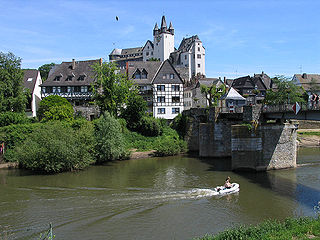
Diez an der Lahn is a town in Germany's Rhein-Lahn district in Rhineland-Palatinate, on the borders of Hesse. Diez is the administrative seat of the municipality of Diez.

Burtscheid Abbey was a Benedictine monastery, after 1220 a Cistercian nunnery, located at Burtscheid, near Aachen, North Rhine-Westphalia, in Germany.

Göttweig Abbey is a Benedictine monastery near Krems in Lower Austria. It was founded in 1083 by Altmann, Bishop of Passau.

Garsten Abbey is a former Benedictine monastery located in Garsten near Steyr in Upper Austria. Since 1851, the former monastery buildings have accommodated a prison.
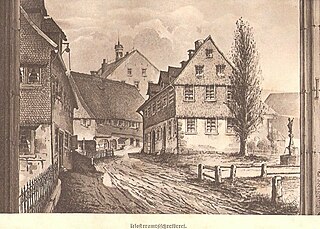
St. George's Abbey in the Black Forest was a Benedictine monastery in St. Georgen im Schwarzwald in the southern Black Forest in Baden-Württemberg, Germany.

Baindt Abbey, otherwise the Imperial Abbey of Baindt, was a Cistercian nunnery in Baindt in the district of Ravensburg in Baden-Württemberg, Germany.

Weissenau Abbey was an Imperial abbey (Reichsabtei) of the Holy Roman Empire located near Ravensburg in the Swabian Circle. The abbey, a Premonstratensian monastery, was an Imperial Estate and therefore its abbot had seat and vote in the Reichstag as a prelate of the Swabian Bench. The abbey existed from 1145 until the secularisation of 1802-1803.
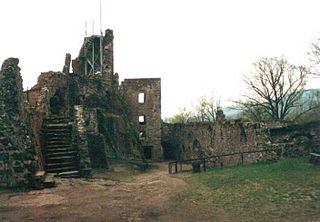
Hohnstein Castle is one of the largest and best-preserved castle ruins in Germany and is located near Neustadt in the vicinity of Nordhausen in Thuringia.

Lady Mary of Looz-Heinsberg, Dutch: Maria van Loon-Heinsberg, was a noble lady from the House of Looz and through marriage Countess of Nassau-Siegen.
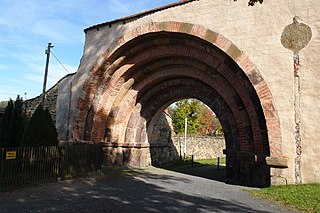
Altzella Abbey, also Altzelle Abbey, is a former Cistercian monastery near Nossen in Saxony, Germany. The former abbey contains the tombs of the Wettin margraves of Meissen from 1190 to 1381.
Rottenmünster Abbey, also the Imperial Nunnery of Rottenmünster, was a Cistercian abbey located near Rottweil in Baden-Württemberg. The self-ruling Imperial Abbey was secularized in the course of the German mediatization of 1802–1803 and its territory annexed to the Duchy of Württemberg. The monastery was closed in 1850. The buildings of the former abbey now house a hospital.

Schloss Schöneck is a castle which stands on a rock outcrop in the Ehrbach Gorge in the borough of Boppard in the Hunsrück mountains of Germany.
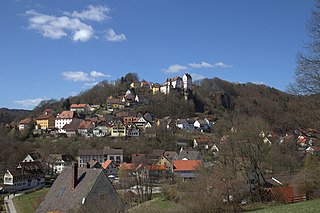
Egloffstein Castle is a former high mediaeval, aristocratic castle, that stands immediately west of the eponymous village of Egloffstein in the Upper Franconian county of Forchheim in the German state of Bavaria.
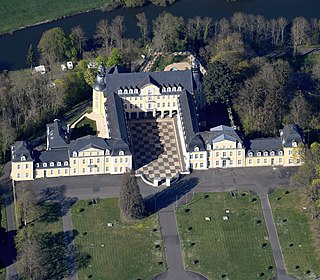
Schloss Oranienstein is one of the palaces of the House of Orange-Nassau, sited at Diez on the Lahn. It was built on the ruins of Dierstein Abbey between 1672 and 1681 for Countess Albertine Agnes of Nassau after she was widowed.

Schloss Kunreuth is situated on the northwestern edge of the eponymous village of Kunreuth which is part of the collective municipality of Gosberg in the county of Forchheim, in the province of Upper Franconia in the south German state of Bavaria.

The ruins of Reifferscheid Castle stand at a height of 450 metres above sea level (NN) near the German-Belgian border between the mountains of the Eifel and the Ardennes in the municipality of Hellenthal. Its name probably comes from a forest clearing that belonged to a man called Rifhari, the names Rifersceith or Rifheres-sceit mean "woodland strip of Rifhari".
Schönbornslust was a palace located in Kesselheim, part of the city of Koblenz in Rhineland-Palatinate, Germany. It was a summer residence and hunting lodge of the Prince-Electors and Archbishops of Trier. It was destroyed by French revolutionary troops in 1794. Today nothing remains of the last palace created by Balthasar Neumann.

Diederik II Count of Limburg Hohenlimburg was a son of Everhard I and Agnes.

Diederik III of Limburg Hohenlimburg, born around 1328, was the eldest son of Everhard II van Limburg Hohenlimburg and Juta of Sayn. Twenty years later he followed the 9th of August 1364 his grandfather Diederik II count of Limburg Hohenlimburg. In 1366 Diederik III became the Amtmann of Angermünde, the district between Duisburg and Düsseldorf. As the successor to lord Diederik III of Broich, who five years later would become his father-in-law. He also was Voght of the Rellinghausen Abbey. On 3 July 1371 Diederik married Ludgardis (Lukarda) daughter of Diederik of Broich and Katharina of Steinfurt. Lukarda was heiress of the Lordship Broich. At his wedding, he received a dowry of 1,600 old gold shields.


















